
|
|||
|---|---|---|---|
|
|
Motor coordination of individuals with intellectual disability: evaluation and intervention |
|
|
|
*Paranaense University - UNIPAR Mestre em Educação Física/Atividade Física, Adaptação e Saúde -UNICAMP Doutorando em Educação Física/Atividade Física, Adaptação e Saúde -UNICAMP **State University of Campinas - UNICAMP |
Prof. M.Sc. Jose Irineu Gorla* Prof. Dr. Jose Luiz Rodrigues** Prof. Dr. Paulo Ferreira de Araújo** gorla@unipar.br (Brasil) |
|
|
|
|
|||
|
|
http://www.efdeportes.com/ Revista Digital - Buenos Aires - Año 9 - N° 63 - Agosto de 2003 |
|
|
1 / 1
Introduction
The present study focused on body coordination in individuals with intellectual disability, which is recognized as an important component of child development and which has been the subject of various studies, albeit slightly precarious ones, especially over the last few decades, given the growing awareness of its importance in motor control during human development, especially during the growth phase.
Some children encounter difficulties in motor abilities such as writing, drawing, handling objects and building, while others have difficulties with recreation, games that involve running, jumping, hopping, throwing, with balance, space and time orientation, side movements, sports and even movement and daily activities.
Genetic and environmental influences have been considered by authors such as Krebs (1997), Pereira et al. (1997) and Gallahue (1998), among others, whose concern focuses on the current lifestyle of the individuals, whether they are normal or deficient, and on the consequences of not having a chance to discover and develop natural movements.
Previously, Kiphard (1976) was concerned about what he called insufficiency of coordination in school age children, making it clear that there was a need to carry out studies that indicated the extent of the problem in order to propose pedagogical actions that allowed for a return of coordinated movement, based on a step-by-step process during the first phases of motor development.
Within this scope, it is necessary to understand how the manifestations of coordination disorders in individuals with intellectual disability occur.
The expression "intellectual disability" uses a condition to classify a specific group of incapacitated people. These people in no way constitute a homogeneous group in terms of behavior, intellectual function, physical abilities, development levels and other pertinent characteristics.
Throughout the years, people with certain intellectual difficulties have received distinct denominations and have been labeled with various names, such as: idiot, imbecile, weak-minded and abnormal, among others. Many denominations and labels were influenced by different social trends, diverse scientific theories and different psychological schools.
The use of the different terminologies to define a situation obeys the conception that each psychological school has with respect to the etiology of intellectual disability. In the most recent publications, the term "mental retardation" appears. In Brazil, the term "mental deficiency" seems to be used more frequently.
People with intellectual disability, that is, with a reduction of adaptability provoked by a permanent loss of certain capacities, present different characteristics of development of their physical designs, space organization, balance, agility and strength, among others. In certain cases, these characteristics can be considered pathological, that is, developing with particularities and sequences that are different from what is considered "normal" development, and in other cases they are simply considered as delayed, meaning the development is normal in every way, except for being behind the chronological age.
The present search can serve as a contribution for the future preparation and training of professionals in the area of Physical Education and others who work with movement, always keeping in mind that currently people with disabilities attend regular schools, and so the same methods of evaluation and intervention can be used as long as attention is given to the way they are applied and taught.
An attempt was also made to establish a relation between pedagogical and therapeutical disciplines, so that they may always continue respecting each other and recognizing the natural limits of education and rehabilitation, thus contributing to the improvement of the sensory and neuromuscular aspects of individuals with intellectual disability. In this way it is very probable that this study will be able to contribute, within the limitations of its scope, with qualitative and quantitative explanations about body coordination in people with intellectual disability.
ObjectivesThe general objective was to analyze the progress of individuals from 6 to 11 years of chronological age, with intellectual disability in relation to the aspects of overall motor coordination, based on the results of a sequential method of evaluation and intervention.
The following specific objectives comprised this scientific analysis:
Evaluation of the capacity of total body coordination, using the Kiphard and Schilling (1974) KTK as an instrument;
Comparison of the results of pre- and post-tests, after an intervention with assisted motor activities;
Analysis of the effect of a pedagogical practice with specific assisted tasks;
Analysis of the variables that contribute to coordination disorders.
MethodologyThis study is of the descriptive type, with a combined exploratory-descriptive content (Lakatos & Marconi, 1991), aiming to analyze the progress of individuals with intellectual disability from 6 to 11 years of chronological age of both the sexes, students of the APAE of Rolândia, state of Paraná, in relation to the aspects of overall body coordination, based on the results of a sequential method of evaluation, using the KTK, and intervention, besides the life history and observations associated with the coordination disorders.
From a set of thiry individuals with intellectual disability, of both sexes, members of the APAE of Rolândia, Paraná, nine students were selected to be research subjects, with chronological ages from 6 to 11. The selection of this sample was intentional; the individuals with the greatest limitations were separated for the study in order to enable an application of the analysis of an assisted program designed for their difficulties and based on the results of the pre- and post-tests of coordination. The selected students were all diagnosed as having intellectual disability without syndromes and belonged to different classrooms. Only one of the subjects was female.
InstrumentsTo evaluate body coordination capacity, the KTK (motor coordination test for children), made up of four tasks, (Kiphard and Schilling, 1974) was used, as well as the reference tables.
Task 1 - Balance Bar:
Objective: steadiness of balance while walking backwards on the bar.Task 2 - Monopedal Jump:
Objective: Coordination of the lower limbs; dynamic energy/strength.Task 3. - Side Jump:
Objective: Speed in side jumps.Task 4. - Platform Transfer:
Objective: side movements; space-time organization.
Preliminary data collectionApplication of the KTK and selection of the subjects
The KTK was applied as a pre-evaluation instrument.
In this stage 30 students were evaluated and 9 were selected to be part of the research. The selection process took into consideration the degree of limitation of their body coordination.
A pilot study carried out with various school-age children in regular schools, with intellectual disability, some having Down's Syndrome, made it possible to assure two important aspects: first, that the test in question was easy to apply and second, that the obtained results were in accordance with the expectations.
Intervention
Specific physical education program
Almost all the intervention methods involve relatively short-term programs, according to Sugden and Wrigth (1998). It is not clear from the literature, however, what the ideal number of sessions would be to solve these coordination disorders.
For Knight et al. (1991) and Henderson (1992), there are restrictions in the literature concerning the research carried out on interventions applied to a specific population and also, the same situation exists concerning the consensus about the various intervention strategies.
The specific task method, suggested by Henderson and Sugden (1992), was used in this study. The purpose of this method is to work with the difficulties presented by the individuals.
After applying the motor coordination pre-test, using the KTK test, it was possible to observe what the variables were in which the subjects had the greatest difficulties and which needed the most attention.
Once selected, the children became part of a 10-week specific task intervention program, in a total of 23 sessions.
In this program, some master lines were selected to direct the work of the group. These program lines involved variables pertinent to the test results: balance, side movements, space-time orientation, speed, agility, rhythm and concentration tasks.
Each week program master lines were selected, initially by the research professor and subsequently in conjunction with the group professor.
The strategy and application of the contents are not new; they are common and widely used in Adapted Physical Education classes. The additional advantage of the specific task method is that it deals directly with the individuals' most significant problems.
A study by Wright and Sugden (1996) showed that in a specific intervention program the activities had positive effects on the difficulties presented by the subjects in the pre-test.
In the present study, a mid-test was applied after the thirteenth intervention session because it became apparent at this point that it was necessary to evaluate the program being developed, since some of the individuals were not progressing. This evaluation proved important in detecting some of the changes that would be necessary before the end of the twenty-third session, thus enabling more reliable work based on more criteria. After the mid-test, there were 10 more intervention sessions and finally the post-test, whose results will be detailed later on in this paper. Statistical treatment
The statistical analysis of the results was done using the Statistics 6.0 program (version for Windows). It should be noted that in the test of body coordination, the option was made to use the overall task results, since there were no reference figures for the Brazilian population, whether normal or diagnosed as having intellectual disability. The results are described as averages (x), as standard deviations (SD), and the student t-test procedure was used to verify the degree of significance, for dependent samples between the pre- and post-tests.
Results and discussionThe analysis of the results derived from this study, based on statistical analyses, made it possible to verify the validity of the problem being presented. The analysis was done both individually and in group and is presented in tables and graphs showing the performance of the subjects in each motor task.
The discussion is based on the results from the tests applied and from the Specific Physical Education Program.
Presentation of the resultsTables 1 and 2 show the results of the initial situation (pre-test) and the final situation (post-test), and Table 4 shows the results of the monopedal jump task, separated for right and left legs.
Considering the group as a whole, the results of the sample revealed relative differences in the balance bar and monopedal jump tasks, while the side jump and platform transfer tasks showed uniform group results, except for Subject I.
The student t-test was used to verify the influence of the activities of the Specific Education Physical Program on body coordination. Table 5 shows the overall test results, and Table 3 shows the results for the monopedal jump test separated for right and left legs.
The score in the column of total points is obtained from the table of respective tasks, reference tables for the test, by crossing the horizontal line corresponding to the specific task score with the vertical line corresponding to the subject's age bracket.
TABLE 1. Average and standard deviation of the individual score of the
study subjects in motor tasks - initial situation.
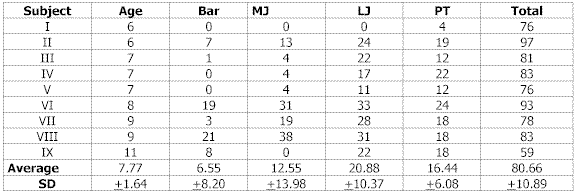
MJ - Monopedal jump, LJ - Lateral Jump, PT - Platform Transfer,
Total Score - figures from the KTK reference table for age, sex and task.Observing the table 2, it is possible to verify the existence of the influence of the motor activities practiced by the group in relation to the table 1. They were found significant differences in level of p < 0,05 in all of the motive tasks and in level of p < 0,01 in the tasks of jump monopedal and transfer on platforms, according to display the table 5 ahead.
TABLE 2. Average and standard deviation of the individual punctuation of the subject
of the study in the motive tasks - final situation.
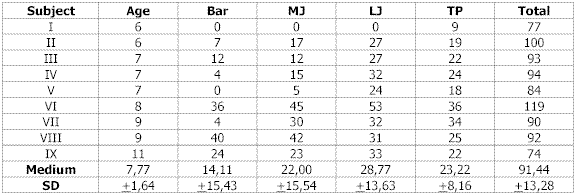
In the results of the jumps executed monopedais, so much with the right leg as with the left (table 3), it is observed that in the powder-test the average of the group was significant in level of p < 0,01 for right leg and in level of and p < 0,05 for both legs.
TABLE 3. Average, standard deviation and results of the test " t " between previous and powder-tests
in the task jump monopedal - legs right and left.
Values statistically significant in level of: the a) p < 0,01 and b) p < 0,05 
There was however, a predominance for the left leg in the previous test.
It is observed that, during the evaluations in the previous test, the children had better results in the jump monopedal in the left leg, however, after the interventions the averages were balanced, in the left leg and in the right.
The child I, didn't progress in this task, according to display the table 4. This child didn't get to maintain in balance with an alone leg, becoming difficult the execution of contrary salto. At against, the child IX, developed considerably, tends his initial average of zero passing for 11,5 points in the powder-test, confirming the influence of the activities this way in the Specific physical education Program.
TABLE 4. Punctuation, average values and standard deviation of the task
jump monopedal - legs right and left.

Of ownership of those results, it became possible to know the motor acting of the subjects, the one that allowed establish some initial considerations that they will be analyzed later, with more depth, starting from the test " t"of Student.
TABLE 5. Average, standard deviation and results of the test " t "
between previous and powder-tests
Values statistically significant in level of: the a) p < 0,01 and b) p < 0,05 
MJ - I Monopedal Jump
LJ-I Lateral Jump
TP-Transfer on PlatformWhen classified in agreement with the test original KTK, it is verified that the group of appraised subjects in this study obtained in the previous tests a medium classification of 80,66 points, what represents a regular classification of corporal coordination.
A probability on this coordination acting would be the lack of exploration of movements for the people with mental deficiency. Genetic and environmental influences have been considered by other authors as Krebs (1997), Pereira et al. (1997), Gallahue (1998), among other, whose concern is centered in the people's current lifestyle and in the consequences that the lack of opportunities of exploration of the natural movements can cause.
After the application of the interventions, a significant increase can be observed in the final classification, resulting in the average of 91,44 points of the group, what would place them inside of a normality for the corporal coordination.
Discussion of the resultsThe corporal coordination was evaluated through the test described already previously in the methodology, that allows to verify the obtained progress, resulting from the influence of the participation of the subjects in a Specific physical education program.
In each task, the results made possible to verify the income of the group, as much as a whole, as separately, as well as to compare the acting values and the growth of the results through the average obtained between the pré and the powder-test.
It was proceeded like this to an analysis by tasks, having been compared the results and outstanding the significância level when found.
The stability of the balance in march on the barAccording to Siegel et al., mentioned by Pereira (1990), the evaluation of the balance on a narrow surface has been a parameter used with base in the variables coordination and stability, for involving the need of the motor control, of the dynamics and of the inhibition of the movement, adjusted to the situation.
The results of this task, observed in the graph 1, they revealed a growth of 100% in the group, in other words, the average that initially was of 6,55 developed for 14,11 after the end of the interventions. In agreement with the table 5, these values were significant estatisticamente in level of p < 0,05, seeming this way, to confirm the influence of the Specific physical education Program lived by the subjects.
GRAPH 01. Result of the average of the task balance in the bar
between previous and powder-test
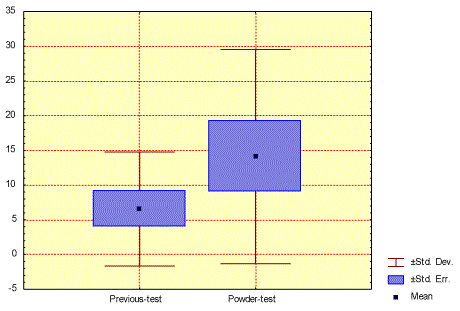
It fits to point out however that, when analyzed individually, according to the tables 1 and 2, the children I, II, V and VII didn't have significant growth in the task balance in march back on the bar. Movement tasks that request precision, stability, directionability and balance, they need a certain concentration degree.
These subjects presented in their behaviors, anxiety situations, amusement, deficit of attention and shyness.
These disturbances impede, in a certain way, the concentration, what might probably have interfered in the acting during the interventions and in the evaluations. This contributed mainly to the subject I, that didn't have evolution none during the intervention, whose results were maintained same between the pré and the powder-test.
It seems us relevant to mention that this presented, during the phases of the program arrhythmic movements, lack of balance capacity and slowness of movements, in the preparation and in the execution of the task.
The balance is fundamental for the motive coordination. As Shallow (1984), a bad balance affects the construction of the corporal outline, because it brings as consequence the loss of the conscience of certain parts of the body. The more defective it is the balance, more energy wears out, resulting psychological consequences, such as anxiety and insecurity.
Several authors as Starosta, Buterfield and Ersing, Jung and Vilkner, Hirtz and Holtz, mentioned by Pereira (1990), they extolled to be indispensable the systematic and growing continuity of the activities to consolidate the balance capacity gradually.
The information that leaves of the tasks and motor sub-tasks of the balance translates, in certain measure, the vestibular and ownceptive integration that it presides all of the surveillance states, of alert and of attention, without which the psychic activity doesn't work, because the control postural involves the participation of inferior centers (marrows), middlemen (cerebral trunk and cerebellum) and superiors (cortex), and its dysfunction interferes with every type of mental activity, no exclusively motive, but emotional, perceptive, cognitive, social and symbolic, among other (Fonseca, 1995).
The brain needs to automate their functions antigravitycal before could process symbolic information. The acquisitions of postures are the prerequisites of the acquisitions specifically human, then its incommensurable importance in the cognitive development (Kiphard, 1976).
The one that she can observe with these explanations is that the children I, II, V and VII, present the behaviors mentioned previously, what certainly contributed to the low indexes in the acting of the balance task in the bar.
Authors as Gubbay (1975), McKinlay et al. (1987) and Piek and Edwards (1997), they are unanimous in affirming that children with coordination problems have difficulties in the learning, problems emotional, social and of behavior.
These children presented, during the execution of the balance task in the bar, pulses improperly fast, abrupt, with slow motive reaction, unbalance, among others. In that way, it happens an instability of the muscular forces, causing a disarray of the body in the movement.
The dynamic energy of the inferior extremitiesThe way of evaluating the dynamic energy of the inferior extremities has been developing in the last decades, starting from the test of Ozeretzki, that proposed jumps on an extended and high rope to variable heights in agreement with the age.
GRAPH 02. Result of the average of the task monopedal jump
between previous and powder-test
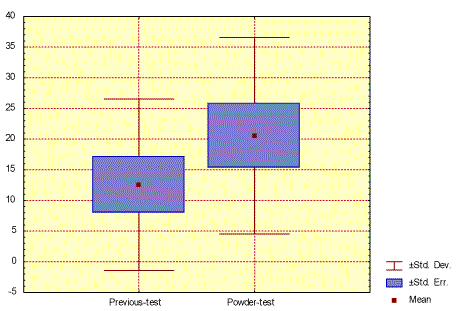
The foam obstacles (put upon blocks) idealized by Kiphard and Schilling (1974), they seem viable for the execution of the monopedal jumps, for they offer not danger to the impact with the apparel, eliminating the fall possibility and of the fear, that could cause psychological blockades and aversion to the task.
The production of an enough amount of movement pulses is of considering as premise of any kinetic income qualitative-coordinative. If the developed force is not enough, the coordination tends to fail.
GRAPH 03. Result of the average of the task monopedal jump between previous
and powder-test in the left leg
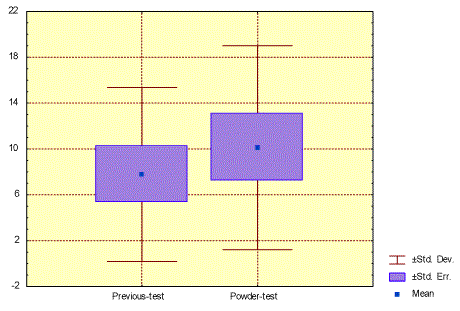
Although it had a significant evolution in the group as a whole, demonstrated in the graph 2, the children I and V didn't present a satisfactory acting in the powder-test, when analyzed individually.
It was quite high the growth of the motor installment of the task monopedal jump, and the average of the group in the previous-test located in 12,55, arriving at the end of the interventions with an average of 21,0 points. It is evidenced like this, a high easiness of execution of this task.
The child I, didn't also have evolution in this task. Given the diversity of their difficulties, it presented during the accomplishment of the evaluations and of the interventions, deficit of potency of the inferior members.
These low actings can be assumed as expected, face to the children's age and the behaviors already told previously. We didn't owe, therefore, to wait a level of motor income in no way completely equal and homogeneous to a certain age.
GRAPH 04. Result of the average of the task monopedal jump between
previous and powder-test in the right leg.
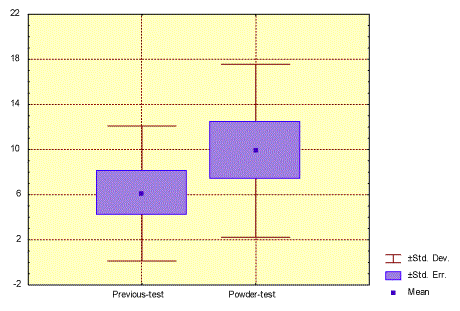
In spite of having worked with intervention sessions, what also reveals a growth in the group, some children didn't have significant improvements in their results in the powder-test, characterizing like this a need of more lingering intervention and more individualized in agreement with the age and with their specific needs.
Those significant differences in the dynamic capacity of the income between right and left indications can be constituted, in certain cases, of defects organic-cerebral againstlateral.
Speed of movements in alternate jumpsIn the lateral jump alternating the side, executed in speed and in two series of 15 seconds, significant results are evidenced for the group, as they are demonstrated in the graph 5, seeming there not to be doubts concerning the existence of an influence of the practice of the activities developed in the program, in the improvement of the acting in the powder-test.
GRAPH 05. Result of the average of the task lateral jump
between previous and powder-test
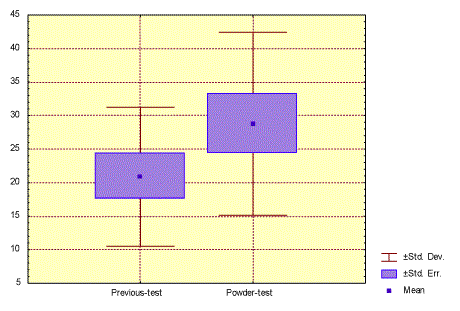
The development this way of movements coordinated in speed present a margin of significant income in the powder-test. These results are due to the easiness of execution of this task. The reaction and the energy dynamics are components of this practice that, according to Clifton and Friederici, mentioned by Pereira (1990), it is demonstrated by the execution easiness, could be stimulated and gotten better.
The child I, in this task, same being she of easy execution, came with difficulties in her accomplishment, not obtaining significant values in the powder-test. Lockart (1980), observed that children from 6 to 12 years have a whole curiosity and realism to the they come across new activities, verifying however, difficulties in the maintenance of the attention.
Inside of the characteristics told individual, just the child I presented problems related with the attention, probably one of the causes that has contributed to the non progress in this task.
She also happened during the execution of the jumps, with this I child, disordered movements, unequal jumps of the feet and alternate fall (stepping for several times in I tinker her dividing), it presented a certain unbalance degree when playing the opposite side of the platform, causing like this, her exit with the foot outside of the same. She also presented reduced speed of the movements.
The income of the coordination bases on the aspect of the rhythm, in the fluidity and in the continuity of the total movement. In agreement with Kiphard (1976), the individual can present symptoms of coordination inadequacy, in case it happens difficulties in such aspects.
As for the child VIII, seems that the sessions of interventions didn't contribute to her income in the powder-test. But it understands each other as relevant to mention that the motor coefficient reached in the previous-test, that is 59 points, it represents a considerable average, inside of a normality for the corporal coordination.
This children (female) presented in their characteristics, a disorganization of progressive temporary sequence, being able to in the interventions, as well as in the moment of the powder-test, to have happened an influence in level of processing of information, because it is verified that in the accountinga of the total motor coefficient the obtaining of significant values in the powder-test, evidencing like this the probability of this to interfere in the moment of the evaluation, in other words, in a certain way, it can block the individual's motor answer, sees the situation of shyness or inhibition during the process of evaluation.
Combined speedThe transfer on platforms was probably the most complex task of executing. Even so, the results found in this motor task were significant statistically in level of p < 0,05, staying the children, therefore, in a good level. The medium results of the previous-test were of 16,4. In the powder-test of this task, the group obtained a growth, reaching an average of 23,2.
When analyzed individually, the child II didn't present evolution in this task, staying with the same initial average. In spite of the 6 year-old age, it maintained a good level in the general result of the test.
GRAPH 06. Result of the average of the task transfer on platform
between previous and powder-test
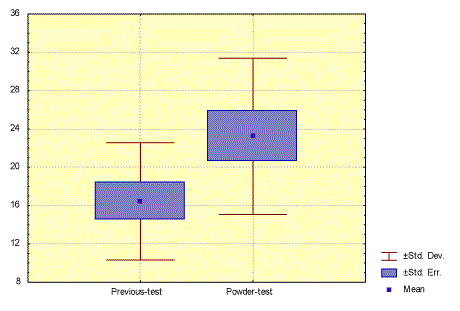
It is possible also to reveal some verifications, in agreement with the results obtained in the execution of the four tasks:
in spite of there being a prevalence of significant results in the group as a whole, the non existence of a complete homogeneity is revealed; the children presented individual differences in some tasks, not getting to progress in the end of the interventions;
the alterations seem current of the influence of the participation in the Specific physical education Program, when the group was improved as a completely;
in the balance task in the bar, the landings reached in the powder-test by the group all was relevant, however it was the task that more revealed child with low individual indexes after the interventions;
of the nine children that participated in the study, seven of them presented in I begin of the program, indexes of corporal coordination to regulate, according to normative tables of Kiphard and Schilling (1974), and, after the twentieth third session of intervention of the Specific physical education Program, only three children continued with regular values, and the others reached values inside for a normality pattern of the coordination.
the children of the study were characterized individually, so that we had some varied that could explain the progress or not in the corporal coordination. In its majority, which more prevailed it was the lack of attention, amusement, shyness and anxiety, that according to Cratty (1976), they will be able to hypothetically to influence in the behaviors of motor planning.
it was verified, also, that all of the individuals had environmental privation of movements, in other words, they didn't participate in extra activities, out of the atmosphere of the school, what has probably contributed to the values not very high of corporal coordination, in spite of most to place inside of the normality patterns, according to normative tables.
ConclusionThe analyses and the done considerations, they take to the conclusion that the subject evaluation and intervention is relevant, should be stimulated in the Special Education, because certainly there would be benefits to the people with mental deficiency and to the own professional in the development of their plannings.
Each one has, for consequence, a motor profile that is specific and equally a profile comportamental that is own.
Given the diversity of their difficulties, it is not easy to identify the measures accurately inside of the Specific Physical Education Program to improve the people's motive abilities with mental deficiency, as well as which tests should be applied.
Being taken into account these limitations, and so that there is acquisition or it gets better of the corporal coordination close to the people bearers of mental deficiency, it becomes necessary to observe some general beginnings, such as:
incentive so much quantitative as qualitative of the motor activities;
analysis of the difficulties that appear in the daily life and of the caused by the deficiency;
elaboration of activities adapted to the specific difficulties of the subjects;
reduction of the influence of the problems of behavior (anxiety, for instance) in the motor abilities;
reduction of the influence of the difficulties concerning the motor abilities about other such functions as the motivation;
stimulation of the such sub-systems as the kinetics or the balance;
stimulation of the development perceptive-motor.
It is necessary also to stimulate and to develop studies inside of that general topic, as for instance:
normative studies, reflecting ethnic-cultural characteristics, relative to behaviors involving the domain of the attention, as well as motor behaviors, that they contribute or, on the contrary, harm an acting of effective performance in the tasks;
the verification of which the types of planned out motive tasks, and of which the tests, that they correspond to specific types of tasks of abilities of the everyday life;
studies to determine the several types of practice of the Specific Physical Education Program (specific or general) they interfere in the evolution or progress of the corporal coordination in a certain number of intervention sessions;
studies that develop normative tables with a Brazilian population with mental deficiency, so that we have parameters of references, and;
they are also made necessary studies on children's populations with specific problems, once they are different in levels and deficiency degrees, trying to associate these to the behaviors adaptatives and not just and simply to the mental deficiency.
Ending, the professionals, therapists, among other, they can be used close to of these general beginnings to stimulate the acquisition or the improvement of the corporal coordination of the people with mental deficiency. It becomes also interesting and necessary to accomplish other studies using these instruments in practice, to verify its adaptation in different contexts social, economical and cultural of our schools.
References
CRATTY, B.J. (1976)- Perceptual and motor development in infants and children. 2ª ed New Jersy, Prentic-Hall, Inc.
FONSECA, V. (1995) Manual de Observação psicomotora: significação psiconeurológica dos fatores psciomotores. Porto Alegre: Artes Médicas. p.371
GALLAHUE, D.L. (1998) - Apontamentos extraídos do curso de desenvolvimento motor - Maringá - UEM.
GUBBAY, S.S. (1975) Clumsy children in normal schools. The Medical Journal of Australia, .1, .p. 233-236
HENDERSON, S.E. (1992) Clumsiness or developmental coordination disorder: a neglected handicap. Current Paediatrics, 2, p. 158-162
HENDERSON, S.E. & SUGDEN, D.A. (1992) Movement assessment battery for children. London: Psychological Corporation.
KIPHARD, E.J. (1976) Insuficiencias del movimiento y de coordenacíon en edad de 1ª escuela primaria. Buenos Aires, p.28
KIPHARD, E.J. & SCHILLING, V.F (1974) Köper-koordinations-test für Kinder -KTK, Beltz Test Gmbh, Weinhein.
KNIGHT, J.F., HENDERSON, S.E., LOSSE, A. & JONGMANS, M.(1991) Clumsy at six-still clumsy at sixteen: the educational and social consequences of having motor difficulties at school. Proceedings of the AIESEP Word convention, lough-borough University, UK.
KREBS, R.J (1997) Teorias dos Sistemas Ecológicos: Um paradigma para o desenvolvimento Infantil- Santa Maria:Universidade federal de Santa Maria, Centro de Educação Física e Desportos.
LAKATOS, E.M. & MARCONI, M.A.(1991) Fundamentos de Metodologia Científica. Editora Atlas, ea. Ed.
LOCKART, A .S.(1980) Motor learning and motor development during infancy and childhood. In CORBIN, C. A text book of motor development, Dubuque, Yowa, W.C, Brown.
McKINLAY, I., BRADLEY, G., HINDLE, A. & EHRHARDT, P.(1987) Motor coordination of children with mild mental handicap. Ups J Med Sci Suppl, n.44, p. 129 -135.
PEREIRA, V.R.(1990) Estudo da influência de um programa desportivo-motor centrado no andebol sobre o desenvolvimento psicomotor das crianças em idade escolar 9 e 10 anos. (Tese de Doutorado). Universidade do Porto.
PEREIRA, V.R.., SOBRAL, F & SILVA, M.J.C.(1997)- Privação ambiental e insuficiências no controlo motor e aprendizagem. Pesquisa inédita. Material não publicado, cedido pelo primeiro autor. Coimbrã, Universidade de Coimbrã, Portugal.
PIEK, J.P & EDWARDS, K. (1997) The identification of children with development coordination disorder by class and physical education teachers. Br. J. Educ. Psychol, n.67, . p. 55-67.
RASO, L.(1984) Educação Física de base: relato de uma experiência. Universidade Federal de Minas Gerais.
SUGDEN .D.A. & WRIGHT, H.C. (1998) Motor coordination disorders in children. SAGE Publications, London - New Delhi.
WRIGTH, H.C.,& SUGDEN,D.A.(1996) The nature of developmental coordination disorder: Inter-and Intragroup Differences. Adapted Physical activity Quarterly, 13, p. 357-371.
| |
|
|---|---|
|
revista
digital · Año 9 · N° 63 | Buenos Aires, Agosto 2003 |
|